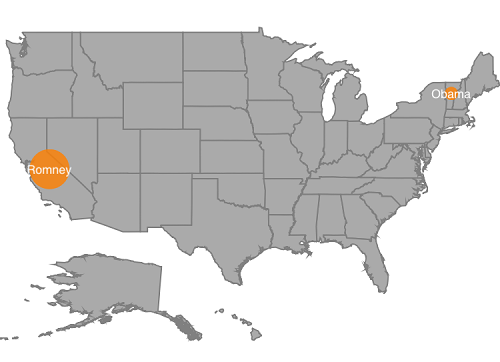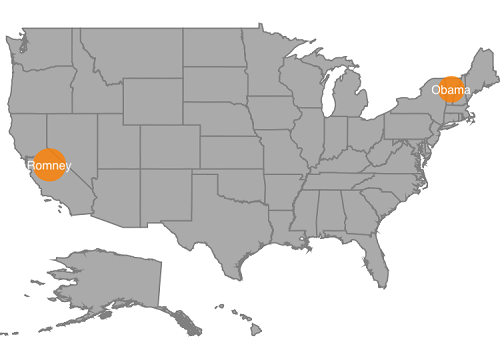Bubble marker
3 Sep 20206 minutes to read
Bubbles in the maps control represents the underlying data values of the map. Bubbles are scattered throughout the map shapes that contain bound values.
Bubble Data
Bubbles are included when the data binding and BubbleMarkerSetting are set to the shape layers.
Below code snippet explains the data binding that is provided for bubble.
SFMap map = new SFMap();
SFShapeFileLayer layer = new SFShapeFileLayer();
layer.Uri = (NSString)NSBundle.MainBundle.PathForResource("usa_state", "shp");
layer.DataSource = GetDataSource();
layer.ShapeIDTableField = (NSString)"STATE_NAME";
layer.ShapeIDPath = (NSString)"State";
map.Layers.Add(layer);
this.View.AddSubview(map);
NSMutableArray GetDataSource()
{
NSMutableArray array = new NSMutableArray();
array.Add(getDictionary("California", "Romney", 55));
array.Add(getDictionary("Vermont", "Obama", 3));
return array;
}
NSDictionary getDictionary(string name, string type, int index)
{
NSString name1 = (NSString)name;
object[] objects = new object[3];
object[] keys = new object[3];
keys.SetValue("State", 0);
keys.SetValue("Candidate", 1);
keys.SetValue("Electors", 2);
objects.SetValue(name1, 0);
objects.SetValue(type, 1);
objects.SetValue(index, 2);
return NSDictionary.FromObjectsAndKeys(objects, keys);
}Adding bubbles
To add bubbles to a map, the bubble marker setting should be added to the shape file layer.ShowBubbles property should be enabled for the bubble to be visible.
ValuePath represents the field value that is to be fetched from the data for each bubble.
SFBubbleMarkerSetting bubbleMarkerSetting = new SFBubbleMarkerSetting();
bubbleMarkerSetting.ShowBubbles = true;
bubbleMarkerSetting.ValuePath = (NSString)"Electors";
layer.BubbleMarkerSetting = bubbleMarkerSetting;Bubble marker customization
Color Customization
The fill color and opacity of the bubbles can be customized using the FillColor and Opacity properties.
SFBubbleMarkerSetting bubbleMarkerSetting = new SFBubbleMarkerSetting();
bubbleMarkerSetting.ShowBubbles = true;
bubbleMarkerSetting.ValuePath = (NSString)"Electors";
bubbleMarkerSetting.FillColor = UIColor.Orange;
bubbleMarkerSetting.Opacity = 0.8f;
layer.BubbleMarkerSetting = bubbleMarkerSetting;
Size customization
The size of the bubbles depends on the data that is bound to the ValuePath but the maximum and minimum size of the bubble can be customized using MaxSize and MinSize properties.
IMPORTANT
ShowMapItemsshould be enabled to display label on bubble marker.
SFBubbleMarkerSetting bubbleMarkerSetting = new SFBubbleMarkerSetting();
bubbleMarkerSetting.ShowBubbles = true;
bubbleMarkerSetting.ValuePath = (NSString)"Electors";
bubbleMarkerSetting.FillColor = UIColor.Orange;
bubbleMarkerSetting.Opacity = 0.8f;
bubbleMarkerSetting.MinSize = 20;
bubbleMarkerSetting.MaxSize = 25;
layer.BubbleMarkerSetting = bubbleMarkerSetting;Following snippet explains the complete code for adding bubbles along with its customization.
SFMap map = new SFMap();
SFShapeFileLayer layer = new SFShapeFileLayer();
layer.Uri = (NSString)NSBundle.MainBundle.PathForResource("usa_state", "shp");
layer.DataSource = GetDataSource();
layer.ShowMapItems = true;
layer.ShapeIDTableField = (NSString)"STATE_NAME";
layer.ShapeIDPath = (NSString)"State";
layer.ShapeSettings.ValuePath = (NSString)"Candidate";
SFBubbleMarkerSetting bubbleMarkerSetting = new SFBubbleMarkerSetting();
bubbleMarkerSetting.ShowBubbles = true;
bubbleMarkerSetting.ValuePath = (NSString)"Electors";
bubbleMarkerSetting.FillColor = UIColor.Orange;
bubbleMarkerSetting.Opacity = 0.8f;
bubbleMarkerSetting.MinSize = 20;
bubbleMarkerSetting.MaxSize = 25;
layer.BubbleMarkerSetting = bubbleMarkerSetting;
map.Layers.Add(layer);
this.View.AddSubview(map);
NSMutableArray GetDataSource()
{
NSMutableArray array = new NSMutableArray();
array.Add(getDictionary("California", "Romney", 55));
array.Add(getDictionary("Vermont", "Obama", 3));
return array;
}
NSDictionary getDictionary(string name, string type, int index)
{
NSString name1 = (NSString)name;
object[] objects = new object[3];
object[] keys = new object[3];
keys.SetValue("State", 0);
keys.SetValue("Candidate", 1);
keys.SetValue("Electors", 2);
objects.SetValue(name1, 0);
objects.SetValue(type, 1);
objects.SetValue(index, 2);
return NSDictionary.FromObjectsAndKeys(objects, keys);
}